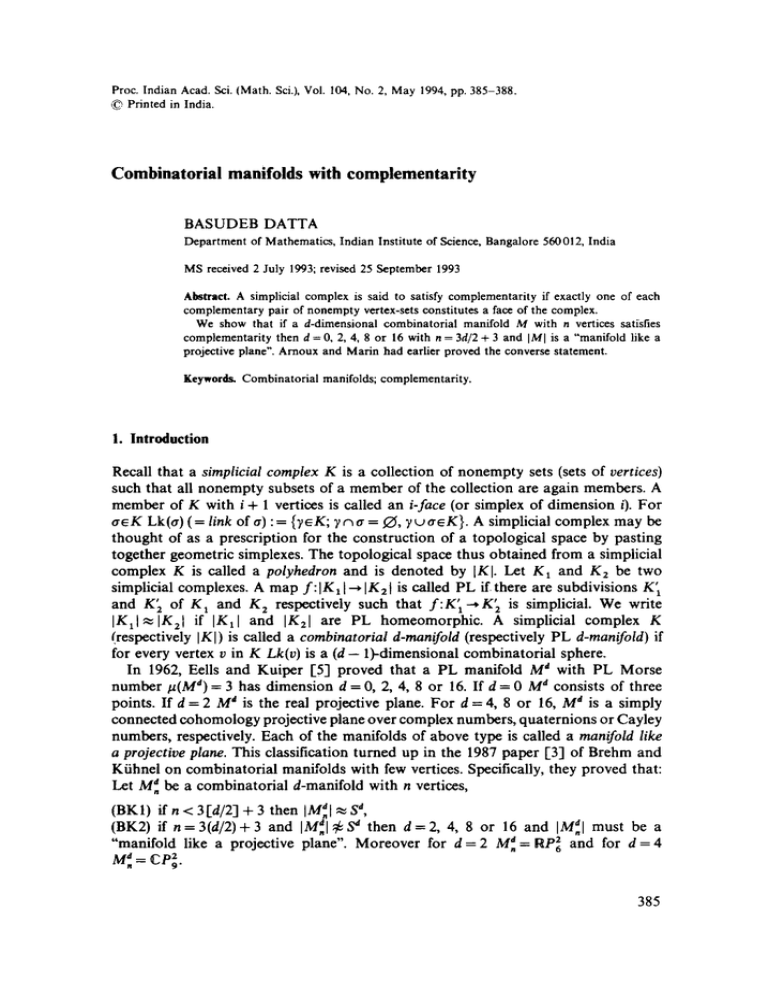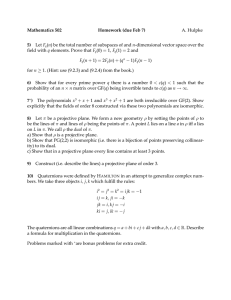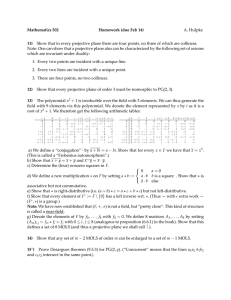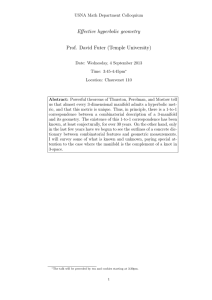Proc. Indian Acad. Sei. IMath. Sci.), Vol. 104,... ~ Printed in India.
advertisement

Proc. Indian Acad. Sei. IMath. Sci.), Vol. 104, No. 2, May 1994, pp. 385-388.
~ Printed in India.
Combinatorial manifolds with complementarity
BASUDEB DATTA
Department of Mathematics, Indian Institute of Science, Bangalore 560012, India
MS received 2 July 1993; revised 25 September 1993
Abstract. A simplicial complex is said to satisfy complementarity if exactly one of each
complementary pair of nonempty vertex-sets constitutes a face of the complex.
We show that if a d-dimensional combinatorial manifold M with n vertices satisfies
complementarity then d = 0, 2, 4, 8 or 16 with n = 3d/2+ 3 and IMI is a "manifold like a
projective plane". Arnoux and Marin had earlier proved the converse statement.
Keyward~ Combinatorial manifolds; complementarity.
I. Introduction
Recall that a simplicial complex K is a collection of n o n e m p t y sets (sets of vertices)
such that all n o n e m p t y subsets of a m e m b e r of the collection are again members. A
m e m b e r of K with i + 1 vertices is called an i-face (or simplex of dimension i). F o r
trek Lk(a) ( = link oftr) : = {~eK; 7 h a = j~, ywtr~K}. A simplicial complex m a y be
t h o u g h t of as a prescription for the construction of a topological space by pasting
together geometric simplexes. The topological space thus obtained from a simplicial
complex K is called a polyhedron a n d is denoted by [KI. Let K 1 and K 2 be two
simplicial complexes. A m a p f : l K l [ ~ IK2i is called P L if there are subdivisions K'I
and K 2 of K 1 and K 2 respectively such that f : K ' 1 --,K 2 is simplicial. We write
I K I I ~ I K 2 1 if I g l l and IK21 are P L h o m e o m o r p h i c . A simplicial complex K
(respectively IKI) is called a combinatorial d-manifold (respectively P L d-manifold) if
for every vertex v in K Lk(v) is a ( d - 1)-dimensional combinatorial sphere.
In 1962, Eells a n d Kuiper 15] proved that a P L manifold M d with P L Morse
n u m b e r / ~ ( M 4) = 3 has dimension d = 0, 2, 4, 8 or 16. If d = 0 M d consists of three
points. If d = 2 M d is the real projective plane. F o r d = 4, 8 or 16, M d is a simply
connected c o h o m o l o g y projective plane over complex numbers, quaternions or Cayley
numbers, respectively. Each of the manifolds of above type is called a manifold like
a projective plane. This classification turned up in the 1987 paper 1"3] of Brehm and
Kiihnel on combinatorial manifolds with few vertices. Specifically, they proved that:
Let M a/ I be a combinatorial d-manifold with n vertices,
( B K I ) if n < 3[d/2] + 3 then IM~I ~ S a,
(BK2) if n = 3 ( d / 2 ) + 3 and IMa,I ~ S~ then d = 2, 4, 8 or 16 and IM~I must be a
"manifold like a projective plane". M o r e o v e r for d = 2 M~=, RP62 and for d = 4
M a = C P 2.
385
386
Basudeb Datta
It is classically known that there exists a unique (up to simplicial isomorphism)
6-vertex triangulation (denoted by RP 2) of the real projective plane RP 2. It is also
known (see [2], ['6] and [7]) that there exists a unique (up to simplicial isomorphism)
9-vertex triangulation (denoted by CP~) of the complex projective plane CP 2.
Implicit in ['3] is the result that CP~ satisfies complementarity. This result was made
explicit by Arnoux and Matin ['1] in 1991. More generally, they proved that any
manifold as in (BK2) satisfies complementarity. In this article we prove the converse:
Theorem. Let M ~, be a combinatorial d-man[fold with n vertices. I f Md~ satisfies
complementarity then d = O , 2, 4, 8 or 16 with n = 3(d/2)+ 3 and IMd, I is a "manifold
like a projective plane".
Preliminaries
Let K be a triangulation of the sphere S p- 1 with n vertices. The f-vector of K is
f(K): = (fo ..... f~- 1), where fi is the number of i-faces in K. Thus fo = n and f~ ~<(~+ 1)
for 1 ~<i ~<p - 1. Let N denote the non-negative integers, and define H:N ~ N as
follows
if
I
H(m) =
i~f~(m~
1)
m=O
(1)
if m>O.
Then there exists (see ['8]) integers ho ..... hp such that
(1 - x ~ ~ H ( m ) x = = h o + h l x + ... + hpx p
(2)
m=O
is an identity in the formal power series ring C [[x'l].
For k ~<p < n - 1 (equating the coefficients o f x t from both sides of(1 + x) -c~-k+ 1)
(1 + xy'=(1 + x ) "+k-p-l) we get
~=o
(3)
k
By substituting i - 1 = p and 1 --- p + 1 - k we get
-j
n
= E ( - 1)'-,,,=t
i--m]\
I-- 1
(4)
Then from (1) and (2) by using (4) we get (see [9])
h,=l-o~ (-l)'-'(:-l)
iflwhere we set f _ 1
= 1.
I,.
(5)
Combinatorial manifolds with complementarity
387
I f f j _ t = (7) for 1 ~<j ~< q ~< p then by (3) we have
h, = ( n + i - p
fori~q.
(6)
T h e D e h n - S o m m e r v i l l e equations, which hold for any triangulation of the sphere
S ~- 1 are equivalent to the statement (see [9]):
h~=hp-t
O<~i<~p.
(7)
3. P r o o f o f t h e t h e o r e m
T h r o u g h o u t , M is an n-vertex c o m b i n a t o r i a l d-manifold satisfying bomplementarity.
It is trivial from the definition that, for d -- 0 M consists of three points, and since
clearly there is no l-manifold satisfies complementarity, we m a y take d >i 2.
W e shall repeatedly use the following obvious consequences of complementarity.
Since no set of >~ d + 2 vertices constitute a face, n ~ 2d + 3 and every set of ~< n - d - 2
vertices is a face. T h a t is, for i ~ n - d - 3, all/-faces occur in M. M o r e generally the
/
n u m b e r of i-faces + the n u m b e r of ( n - i - 2 ) - f a c e s - - ( / - - ~ ) .
\
As each vertex forms
a 0-face, therefore n > d 4- 2. Thus, d + 2 < n ~ 2d + 3.
T h r o u g h o u t this section we put c = [d/2]. Thus, d -- 2c - 1 or 2c.
If F~ is the n u m b e r of/-faces in M then we have:
9-3
SFo+(FI+F2m_3)+...+(F,_2+Fm)+F~_I
)". F~=
i=0
).Fo+(Fx+F2m-2)+'"+(F,~-I+Fm)
ff n=2m,
if
n=2m+l
I
= 2 "-1 -- 1,
which is an o d d integer, where we set F~ = 0 for i > d. Therefore the Euler characteristic
of M -- Y.7-03( - I)'F, is odd.
If n = d + 3 then (by (BK1)) M is a sphere.
If n > d + 3 then all the i-faces occur in M for i ~< n - d - 3 1> 1. Therefore the link
of any vertex in M is an ( n - 1)-vertex combinatorial ( d - 1)-sphere with f - v e c t o r
satisfying: f~ = (~+ ~) for 0 <~ i ~< n - d - 4. Hence by (6), the h-vector of this link satisfies
hi = ('-d~
TM)for O<~i<~n--d-3.
c - 1 1 ~," W h i c h
If d = 2c then b y (7) for n > 3c + 3, we get ("~_~] 3) = hc - 1 = he+ 1 _- t9, -~+
gives n = 2c + 2, c o n t r a r y to o u r a s s u m p t i o n in this case.
l f d = 2c - 1 then for n t> 3c + 3, we get (,~_~2) = h,_l = h~ = ("-~-~c ). Which gives
n = 2c + 1, a contradiction.
Thus, n ~< 3c + 3 if d is even and n < 3c + 3 if d is odd. Therefore, by (BK1) and
(BK2) M is either a sphere or a "manifold like a projective plane". But as Euler
characteristic of M is odd, M c a n n o t be a sphere. This completes the proof.
388
Basudeb Datta
Acknowledgement
The a u t h o r is thankful to B Bagchi for suggesting this problem and for n u m e r o u s
useful conversations. This work has been d o n e when the a u t h o r was a Visiting Scientist
at the Indian Statistical Institute, Bangalore, and the a u t h o r expresses his gratitude
for their hospitality and support. T h e a u t h o r is also thankful to the referee for pointing
out the fact that complementarity implies the Euler characteristic is odd, which helped
to shorten the proof.
References
[1] Arnoux P and Marin A, The Kiihnel triangulation of complex projective plane from the view-point
of complex crystallography (part II), Memoirs of the Faculty of Sc.. Kyushu Univ. Set. A 45 (1991)
167-244
[2] BagchiB and Datta B, •n K •hnel's 9.vertex c•mp••x pr•jective p•ane• Ge•metriae Dedicata (t• appear)
[3] Brehm U and Kiihnel W, Combinatorial manifolds with few vertices. Topology 26 (1987) 467-473
[4] Brehm U and Kiihnel W, 15-vertex triangulation of an 8-manifold, Math. Ann. 294 (1992) 167-193
[5] Eells Jr J and Kuiper N H, Manifoldswhich are like projective plane, Publ. Math. I.H.E.S. 14 (1962)
181-222
[6] Ktihnel W and BanchoffT F, The 9-vertex complex projective plane, The Math. lnteU. 5 No. 3 (1983)
11-22
[7] Kiihnel W and Lal3mann G, The unique 3-neighbourly 4-manifold with few vertices, J. Combin.
Theory (A) 35 0983) 173-184
[8] Stanley R P, The Upper Bound Conjecture and Cohen-Macaulay Rings, Stud. Appl. Math. LIV (1975)
135-142
[9] Stanley R P, The Number of Faces of a Simplicial Convex Polytope, Adv. Math. 35 (1980) 236-238





